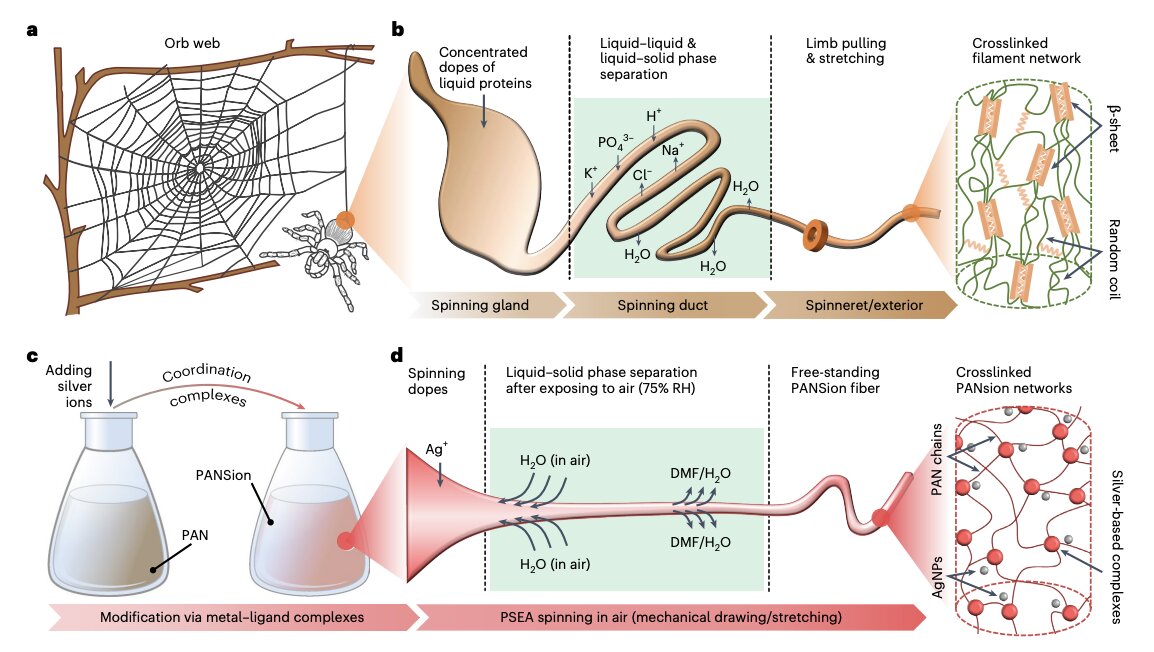

Scientists have been working on developing soft and flexible fibers to create new electronics, such as smart sensing clothes, energy solutions, and wearable biometric devices. Recently, researchers from National University of Singapore, University of California Los Angeles (UCLA), and Nanjing University in China introduced a new method to create soft textiles with electronic properties. This new method was inspired by the process through which spiders spin the silk threads used to create their webs.
The researchers produced a solution containing polyacrylonitrile (PAN) and silver ions dissolved in dimethylformamide (DMF). The silver-based complexes in this solution, referred to as PANSion, strengthens the dope used to spin fibers, allowing it to be spun at ambient temperatures and pressures. This is a notable achievement, as many previously proposed methods to spin functional fibers require high pressures and thermal heating. The researchers’ proposed spinning process is thus far easier to implement on a larger scale, as it has fewer environmental requirements and consumes lower amounts of energy.
The silver ions in the solution are reduced to silver nanoparticles (AGNP), which also allows spun textiles to conduct electricity. The resulting fibers could thus prove very valuable for creating smart textiles, thin energy devices and even wearable sensors. When the researchers’ solution is spun into fibers, it undergoes a spontaneous liquid-solid phase transition prompted by its exposure to air and humidity. The process through which this happens is known as a non-solvent vapor-induced phase separation (NVIPS).
The researchers were successful in creating soft functional fibers that are mechanically stretchable (more than 500% strain), strong (more than 6 MPa), and electrically conductive (around 1.82 S m−1). These properties make the fibers highly desirable for use in creating smart textiles.
The researchers demonstrated the feasibility of their spinning technique by creating fibers that they used to create two different devices, a sensing glove, and a smart face mask. For the sensing glove, they used a commercially produced glove as a substrate, on which they sowed their PAN-Sion spun fiber. Changes in resistance picked up by this smart glove were picked up when it was bent or approached cold and warm surfaces, which were then converted into signals that could be transmitted to digital devices. The sensing mask created by the researchers was created by sewing the PANSion spun fiber onto a filter layer. When a user wearing this mask breathed in and out, this generated changes in resistance that could also be translated into signals, enabling the monitoring of the wearer’s breathing.
In the future, the fibers created by the researchers could be used to create a wide range of other devices and wearable technologies. Their proposed spinning technique and the solution it is based on could inspire the development of similar approaches to create functional fibers with electronic properties. The soft fibers can be used to make smart textiles for use in energy, sensing, and therapeutic applications. However, the fabrication of functional fibers is difficult compared with the fabrication of two-dimensional films and three-dimensional monoliths, and current methods typically require high temperatures, high volumes of solvents or complex systems. The new spinning approach to fabricate functional fibers is based on spontaneous phase separation and is inspired by the silk-spinning processes of spiders.
As humanity grapples with the looming urgency of climate change, a fascinating solution may lie…
As the imperative to achieve net-zero carbon emissions grows stronger, the complexities facing power grid…
Dark matter has become one of the most tantalizing puzzles of modern astrophysics, with its…
Recent groundbreaking studies led by scientists from the Scripps Institution of Oceanography at UC San…
At first glance, the cosmos appears to be a structurally sound bastion of stability, having…
A groundbreaking study spearheaded by researchers at the University of Copenhagen has illuminated the profound…
This website uses cookies.